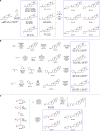Development of Selective Steroid Inhibitors for the Glucose-6-phosphate Dehydrogenase from Trypanosoma cruzi
- PMID: 32551008
- PMCID: PMC7294730
- DOI: 10.1021/acsmedchemlett.0c00106
Development of Selective Steroid Inhibitors for the Glucose-6-phosphate Dehydrogenase from Trypanosoma cruzi
Abstract
Chagas disease is a parasitic infection affecting millions of people across Latin America, imposing a dramatic socioeconomic burden. Despite the availability of drugs, nifurtimox and benznidazole, lack of efficacy and incidence of side-effects prompt the identification of novel, efficient, and affordable drug candidates. To address this issue, one strategy could be probing the susceptibility of Trypanosoma parasites toward NADP-dependent enzyme inhibitors. Recently, steroids of the androstane group have been described as highly potent but nonselective inhibitors of parasitic glucose-6-phosphate dehydrogenase (G6PDH). In order to promote selectivity, we have synthesized and evaluated 26 steroid derivatives of epiandrosterone in enzymatic assays, whereby 17 compounds were shown to display moderate to high selectivity for T. cruzi over the human G6PDH. In addition, three compounds were effective in killing intracellular T. cruzi forms infecting rat cardiomyocytes. Altogether, this study provides new SAR data around G6PDH and further supports this target for treating Chagas disease.
Copyright © 2020 American Chemical Society.
Conflict of interest statement
The authors declare no competing financial interest.
Figures






Similar articles
-
Binding Mode and Selectivity of Steroids towards Glucose-6-phosphate Dehydrogenase from the Pathogen Trypanosoma cruzi.Molecules. 2016 Mar 17;21(3):368. doi: 10.3390/molecules21030368. Molecules. 2016. PMID: 26999093 Free PMC article.
-
Glucose 6-Phosphate Dehydrogenase from Trypanosomes: Selectivity for Steroids and Chemical Validation in Bloodstream Trypanosoma brucei.Molecules. 2021 Jan 12;26(2):358. doi: 10.3390/molecules26020358. Molecules. 2021. PMID: 33445584 Free PMC article.
-
Targets and Patented Drugs for Chemotherapy of Chagas Disease in the Last 15 Years-Period.Recent Pat Antiinfect Drug Discov. 2016;11(2):74-173. doi: 10.2174/1574891X11666161024165304. Recent Pat Antiinfect Drug Discov. 2016. PMID: 27784230 Review.
-
Discovery of new uncompetitive inhibitors of glucose-6-phosphate dehydrogenase.J Biomol Screen. 2014 Dec;19(10):1362-71. doi: 10.1177/1087057114546896. Epub 2014 Aug 13. J Biomol Screen. 2014. PMID: 25121555
-
Trypanocidal drugs for late-stage, symptomatic Chagas disease (Trypanosoma cruzi infection).Cochrane Database Syst Rev. 2020 Dec 11;12(12):CD004102. doi: 10.1002/14651858.CD004102.pub3. Cochrane Database Syst Rev. 2020. PMID: 33305846 Free PMC article.
Cited by
-
Identification and characterization of the anti-SARS-CoV-2 activity of cationic amphiphilic steroidal compounds.Virulence. 2022 Dec;13(1):1031-1048. doi: 10.1080/21505594.2022.2085793. Virulence. 2022. PMID: 35734825 Free PMC article.
-
Consumption of Galactose by Trypanosoma cruzi Epimastigotes Generates Resistance against Oxidative Stress.Pathogens. 2022 Oct 11;11(10):1174. doi: 10.3390/pathogens11101174. Pathogens. 2022. PMID: 36297231 Free PMC article.
-
Inhibition of L-threonine dehydrogenase from Trypanosoma cruzi reduces glycine and acetate production and interferes with parasite growth and viability.J Biol Chem. 2025 Feb;301(2):108080. doi: 10.1016/j.jbc.2024.108080. Epub 2024 Dec 13. J Biol Chem. 2025. PMID: 39675710 Free PMC article.
-
Boosting the Discovery of Small Molecule Inhibitors of Glucose-6-Phosphate Dehydrogenase for the Treatment of Cancer, Infectious Diseases, and Inflammation.J Med Chem. 2022 Mar 24;65(6):4403-4423. doi: 10.1021/acs.jmedchem.1c01577. Epub 2022 Mar 3. J Med Chem. 2022. PMID: 35239352 Free PMC article. Review.
-
Diversification of aliphatic C-H bonds in small molecules and polyolefins through radical chain transfer.Science. 2022 Feb 4;375(6580):545-550. doi: 10.1126/science.abh4308. Epub 2022 Feb 3. Science. 2022. PMID: 35113718 Free PMC article.
References
-
- WHO . Chagas disease (American trypanosomiasis) fact sheet. https://www.who.int/en/news-room/fact-sheets/detail/chagas-disease-(amer...) (accessed 2020-04-08).
-
- Maya J. D.; Cassels B. K.; Iturriaga-Vásquez P.; Ferreira J.; Faúndez M.; Galanti N.; Ferreira A.; Morello A. Mode of Action of Natural and Synthetic Drugs against Trypanosoma Cruzi and Their Interaction with the Mammalian Host. Comp. Biochem. Physiol., Part A: Mol. Integr. Physiol. 2007, 146 (4), 601–620. 10.1016/j.cbpa.2006.03.004. - DOI - PubMed
LinkOut - more resources
Full Text Sources
Chemical Information
Miscellaneous

